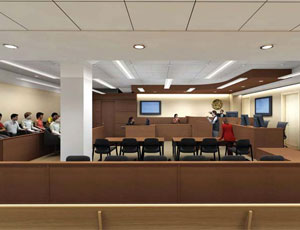It may not appear so from the outside, but inside the five-story concrete shell of the old B.F. Sisk Courthouse in Fresno, a new $70-million ($56 million in construction costs) Superior Courthouse is taking shape.

“We are completely transforming the interior of this 1960s federal court building into a modern courthouse,” says David Moore, lead architect for the San Francisco office of SmithGroup Architecture. “It’s a complete gut and renovation.”
The 192,000-sq-ft make-over broke ground in July 2008 and is scheduled for completion in late 2010.
The project owner is the Judicial Council of California - Administrative Office of the Courts. Rutherford and Chekene of San Francisco is serving as structural engineer and New York City-based Turner Construction is construction manager.
Turner was selected through a best-value delivery method, which is essentially the same as CM-at-risk, says Moore. He says the owner went through the normal CM-at-risk process of quality and competitive selection, with firms submitting proposals.
“But after the proposals, there was an interview panel set up to interview the firms,” says Moore, who was a member of the selection panel. “In this arrangement the owner has some flexibility in supporting the contractor on changes and the contractor doesn’t get hurt in this equation unless he does something really stupid.”
Barry Owens, Turner project executive, says with this delivery method, the owner gets the “benefit of the CM builder onboard during the earliest point of design” to help price the project, provide value engineering and support the design team.
When finished, the structure will house the Superior Court of California, County of Fresno, and feature 15 new courtrooms.
Highlights include administrative offices, holding cells, café, child-care center, electronic public information devices and architectural features to improve public navigation throughout the building.
“The big architectural improvement was that we brought great clarity to how the public will find its way through the building, starting with the lobby and going through security and to make the clerk offices and the courtrooms,” Moore says. “And so there are a lot of visual cues with architectural materials that give people a vocabulary for the public spaces.”
This idea can be seen in features such as strong floor graphics at every elevator lobby and signature porcelain tile that leads visitors from the first-floor lobby to the elevators and up through the fourth floor.
The facility will improve efficiency and access to justice by combining civil, family, probate, family support and family law into one facility, says Teresa Ruano, communications specialist for the owner.
Moore says that because the courthouse was built to mid-1960’s standards, it had unusually low ceiling heights. “A normal courthouse today has a 15- to 17-ft floor-to-floor height, but this building was difficult because I had to work around a 12-ft 6-in floor height,” he says.
Turner’s Owens says a modern courthouse building needs “quite a bit” of ceiling space for air-delivery systems, and this project offered little.
“We had to deal with the problem in the most effective way that we knew and that was to use BIM,” Owens says. “So we took David’s drawings and converted them into 3-D and then we modeled the entire project, while working closely with the design team.”
Once the project was modeled, he says crews were able to work the air and mechanical systems around the perimeters of the courtrooms instead of directly overhead.
Owens says BIM also assisted in seismic upgrading on the fifth floor. He says that in this area, the structural engineer selected a carbon fiber enclosure to seismically upgrade the columns. “This stuff replaces the steel-jacketed column wraps that are seen on highway bridges and things of that nature,” he adds.
He says crews used the wrap on about 28 columns on the top floor, and the rest of the building was reinforced with concrete in-fills in various existing openings, such as stairways, duct openings and shear walls.
The Sisk building was vacated in 2005 when the Robert E. Coyle United States Courthouse was dedicated. The federal government then agreed to convey title for $1 for use by the Superior Court with the stipulation that the building be used for the administration of justice.
If you could perfectly illustrate a traffic bottleneck, just take a look at downtown Lincoln on a busy evening commute. At two lanes, State Route 65 runs through the city, oftentimes at a pace slower than a crawl in this city of 42,126.
To make matters worse, 7% of the vehicles that travel the route are trucks and almost half of those are five-axle vehicles or larger.
The need for a new section of SR 65 around the city has been on Caltrans’ wish-list for some time, ever since Forbes.com listed Lincoln as the nation’s fastest growing city from 2000 to 2006 with an increase of 238.6% in population. This growth is due to Lincoln being located in the rapid suburban development north of Sacramento, in Placer County.
And though homebuilding in Lincoln and environs has obviously quieted down with the lumbering economy, the downtown bottleneck has not.



Post a comment to this article
Report Abusive Comment